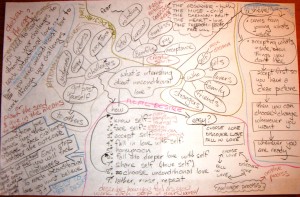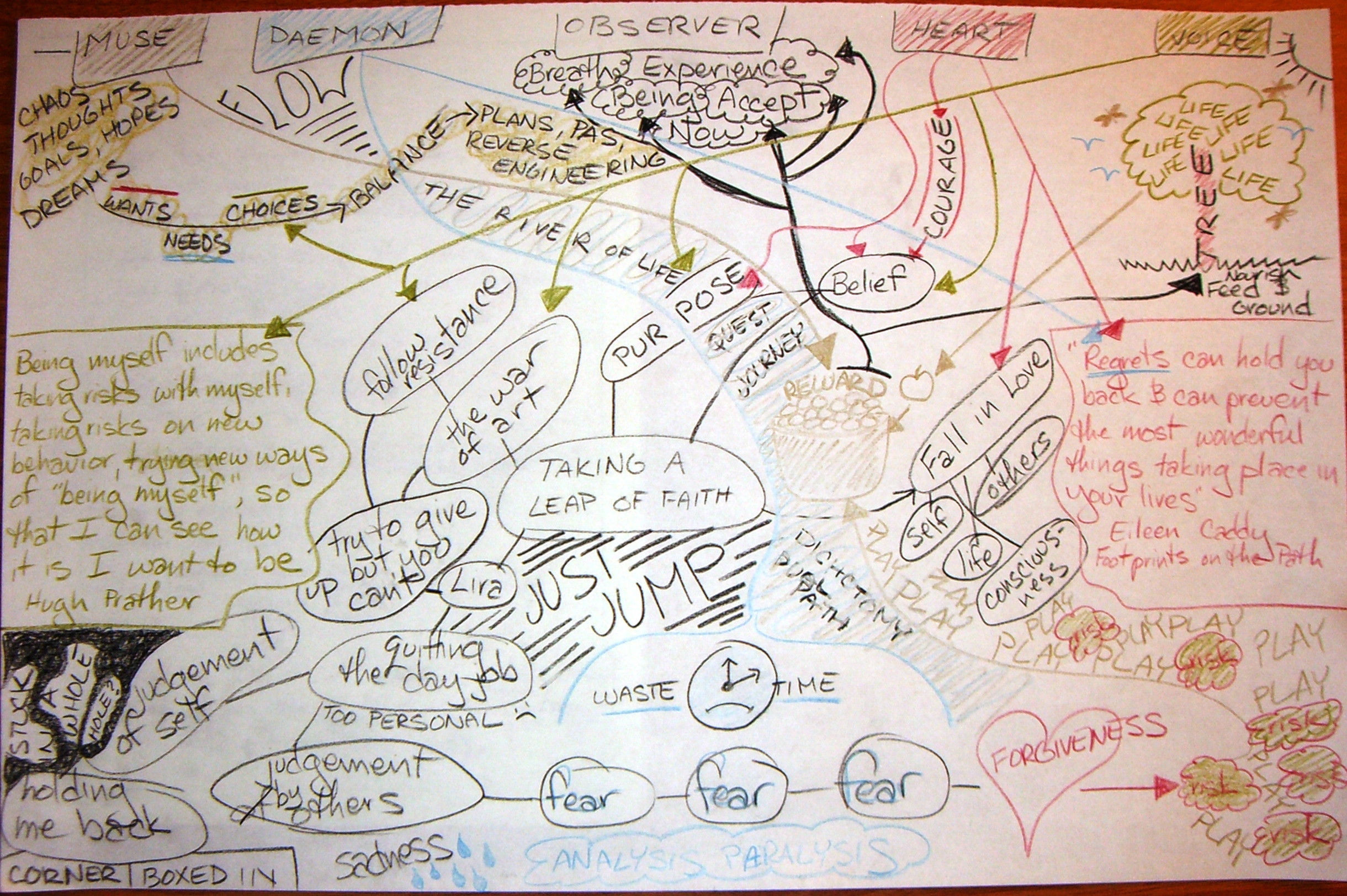Bubble Brainstorming, or just bubbling to those of us that use it constantly, is a wonderful playground to let your Muse, your creative right brain, go wild. It gets your ideas on paper and gives them fertile ground to grow. It also makes your Daemon, your judgmental left brain, shut-up! I absolutely swear by this creative technique for every writing project.
Bubble Brainstorming is very simple, very powerful, and very messy.
1. Set a timer for at least 30 minutes.
In the beginning, this tells your Muse when its okay to play and helps quiet your Daemon by defining a specific start and stop time. Once you are using the bubbling technique more often, the timer will actually keep you and your Muse from getting lost for hours and hours. Remember, the goal of bubbling is to have lots of ideas for a creative project. Its not to bubble indefinitely and be found asleep at your desk, covered in crayola wax, with a vacant expression on your face.
2. Gather blank construction paper & crayons, colored pens, colored pencils, or any colored writing utensils you can find.
I love a mix of colored pencils, chalk pencils, and pastel highlighters. Do NOT use an eraser! Your Muse hates erasers. Your Daemon loves them. Whenever you are bubbling, convince yourself that erasers do not exist. As my favorite fiction writing instructor, Holly Lisle says “Your Muse does not make mistakes!”
3. Write your question or creative focus in the center of the paper and draw a circle around it.
Or a square. Or a triangle. Or a tree. Make sure you tell your Muse right off the bat, that its time to come out and get crazy.
4. Draw 5 or 6 lines of any length from the center circle.
It might look exactly like the “sun” you used to draw in kindergarten or it might not. Most of my center bubbles look like the stick figure of a three legged dog without a head.
5. Write down anything that comes to mind when you look at your topic.
Use whatever words, sentences, or drawings that your Muse throws at you. Include your spelling mistakes, misshapen doodles, and accidental bubble connections. Do NOT let your Daemon’s judgment or organization creep onto the page.
6. Circle any new words that are important and draw lines between words that your Muse associates together.
Be creative with your connection lines. Draw pictures with your words and words with your pictures.
7. Continue bubbling with each new topic or group that shows up on the page until it is full.
…or until your 30 minute session is over. At this point, some people put the drawing aside, let it rest for a day or two, and then add anything to it that comes to mind in the interim. I don’t. My Daemon can’t stand leaving things alone and completely unorganized for two days. So I immediately move on to the next step. When you are first learning this technique, try it both ways and see which one works best for you.
8. Set your timer for another 30 minutes and tell your Muse and your Daemon that its time to PLAY NICE.
9. Define the goal to be a simple organization of the bubbled information created directly on your Bubble Map.
Your Daemon loves goals and rules. However, define the rules such that you must connect all the ideas using drawings, doodles, stars, big arrows, or by color coding your bubbles. Your Muse loves to color and draw. If you hold onto both the goal and the rules, you will get the Muse and the Daemon to work together. And together, they’ll come up with much better connections that you could have imagined.
10. After finishing this loose organization, let your Daemon write the detailed outline that you’ll need to create your first draft.
Some artists can skip this step, but I find it essential. Otherwise, I stare back and forth between my Bubble Map and my computer screen, and constantly ask myself…
“What in the hell was I thinking when I drew that butterfly tree? or How did I logically connect that tiger-heart and the word RISK?”
Once you finish the Bubble Map and its organizational structure, celebrate the merging of your left and right brain by taking a brake from all critical thinking. This is the perfect time to head to the gym, go for a run, or take a yoga class.
When you are ready to come back to the project after a few hours or a few days, create the first draft. Edit, edit. Sigh, because the editing will NEVER be done. Edit once more.
Accept it’ll never be perfect, and then smile as you present the final result to your audience.
BREAK
| How do you brainstorm for creative ideas? What kind of results do you get after using Bubble Maps? Share your ideas in the comment section! |
If you enjoyed the article, please subscribe to LiraVaughan.com and share it with your friends using the Share & Enjoy social bookmarking sites. Thank you for your support!






Interesting that you should post about this. I downloaded an open-source application* to do the same thing using mind-maps. Good for brainstorming (as you said), I was going to try it as a completely new way to take notes. Normally my brain works in outline form, so it’s going to take some getting used to.
By the way, I was the guy with the Kindle sitting next to you at the LATFOB Science panel. I found your url in my notes and thought I’d check it out.
*FreeMind. http://freemind.sourceforge.net
@Jon:
I remember you. You had great Kindle advice! Thanks for visiting my blog.
I’ve looked at the FreeMind software. Its pretty good. I actually prefer a software called Cayra* though. For me, Cayra is better at bringing out my Muse than the FreeMind software because its more colorful and organic. But pen & paper is the best so far.
Getting that analytical Daemon to be quiet can be a chore. Please let me know how the transition goes. 🙂
*Cayra http://cayra.en.softonic.com/
@Lira:
Thanks for the Cayra tip. Color is definitely a value-add, I agree with you. I’ll check it out (especially since its free!) I haven’t fully adopted FreeMind yet…
Listen, I should have posted this on my last comment. I want to give you the blog address of someone who lives in kinda/sorta the same space as you (creativity and the way the mind works). Perhaps you’ve heard of her, Kathy Sierra? Actually, she doesn’t blog anymore – some nut case scared her away. She’s still around the industry though, slowly coming back to the speaking circuit. She has left her blog archive up. She’s also co-published several tech books. You might want to check out her blog when doing research on your own stuff. Kathy rocks, has the respect of a lot of giants in my industry.
*Kathy Sierra: http://headrush.typepad.com/creating_passionate_users/
@Jon: I haven’t heard of Kathy yet, but the site looks very interesting. I’m sorry she is no longer blogging, but I’ll definitely give her books & any seminars a longer look. Thanks!
Okay Lira – I took the instructions in your post and synthesized it with some of Kathy Sierra’s advice (have you checked out her site yet?) and created my first bubble brainstormed mind map… by hand.
The problem with the mind-map software is that it is just not graphic enough. I would love to show you what I created but my company wouldn’t be too happy. So let me tell you. In addition to bubbles, arrows, and plenty of text on the paper, there are crudely drawn illustrations of books, a camel, bundles of straw, binoculars, a rotary telephone, planets in orbit around the sun and a cup of coffee. All for a business challenge! That just can’t be done with software and be in the same state of mind.
The individual illustrations are quite crappy, but collectively it makes for an interesting illustration. It needs to be crude. It begs to be crude.
So, what does it do? According to a book I’m reading on Kindle http://www.amazon.com/Blink-Power-Thinking-Without/dp/0316172324 I am already priming my active subconscious to bring about the vision I just mind-mapped.
Whew!
@jon I too prefer colored pencil & paper because you can make “crude” drawings. Plus, drawing is a great way to get your Daemon to shutup & get your Muse come out to play.
So now that you have an awesome mindmap, you have to finish with steps 8-10. Get your analytical mind back on the playing field (your Daemon) and synthesize the details. Just make sure the Daemon & the Muse PLAY NICE.
What you’re looking for here isn’t just organization, its also the epiphanies you find when you look at the random connections on your map. For example, if I saw a camel drawn next to books I might start to think about ancient Egyptian scholars, or long desert journeys, or making information easier to carry on a trip.
Give your map a rest and then pull it back out when you feel your active subconscious is primed (as you’ve described from Blink: The Power of Thinking Without Thinking) The rest will come to you!